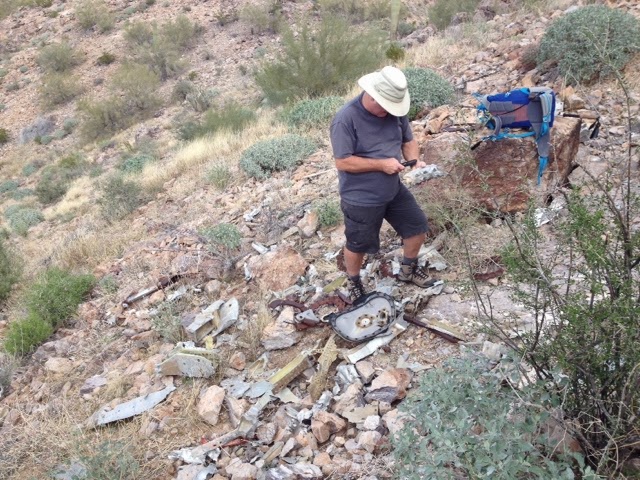Tanques in the Desert
Odometer 37747
Trip Meter 0
Tuesday February 4, 2014
My friend Mark took me out to show me something special in the Barry Goldwater Gunnery Range north of town. There is an area out in Area B where an arroyo crosses over a large area of solid rock.
The indentations in the rock, and between rocks, collect rain water as it gushes over and it becomes a watering area for game animals for many days afterward. These trapped pools of water were often many feet wide and sometimes very deep, giving them the Spanish name "tanques", meaning cistern or tank, in English It was a very important area for the early inhabitants of the desert as it provided a much needed supply of water and a place where food could be ground and prepared in "metates" or bowls formed in the rock.
Water could be dipped out of the tank and dribbled into the hole to help form the mash.
The desert here is showing signs of greening- this area was taking on a park- like appeal.
Several plant species are starting to bloom and the effect is stunning!
Thursday Feb 8, 2014
Mark invited me to go out to an aircraft wreck site that he has been to before, a ridge where an F-104 crashed after the German pilot successfully bailed out.
On our hike out to the site, Mark alerted me that we would be entering a very special geologic area.
Very soon I started noticing some very interesting specimens that looked a lot like fossilized wood.
We started to hike up a very steep ridge to the wreck site when I noticed a cave, and I just had to detour over to check it out.
The cave was formed out of molten lava and the designs on the walls of the cave were fascinating.
The "cave" wasn't all that deep, but I just had to try it out- so I crawled inside and with my back against the far wall I took this photo. In my imagination, some ancient predecessor had used this cave as home. I looked for petroglyphs and relics, but found none. Oh well, it was cool anyway.
Mark Lankford standing at ground zero.
A very short while later we began finding pieces of the F-104. This wreck site was fun, because there was still a lot left to see.
This site had lots of pieces that we could identify. We found landing gear struts, a large piece of the vertical stabilizer, a chunk of a wing-tip tank, turbine blades, etc. etc. Some of the aluminum castings were very very impressive.
We spent about an hour scouting the area and then headed back down the ridge- heading back to the truck about a mile and a half away.
I decided to follow a drainage wash on my way down and discoved that I was walking on a "flow" of igneous rock that was encrusted with geodes. I did a double take, because it looked like a sea scape with barnacles and shells
The marbles are especially neat- they are almost perfectly round and come in a variety of colors-
There is a place near here that is named Marble Mountain because of the hundreds of these small marble sized stones that are found around the base.
Your Traveling Friends
Jeff and Joan













Comments
Post a Comment